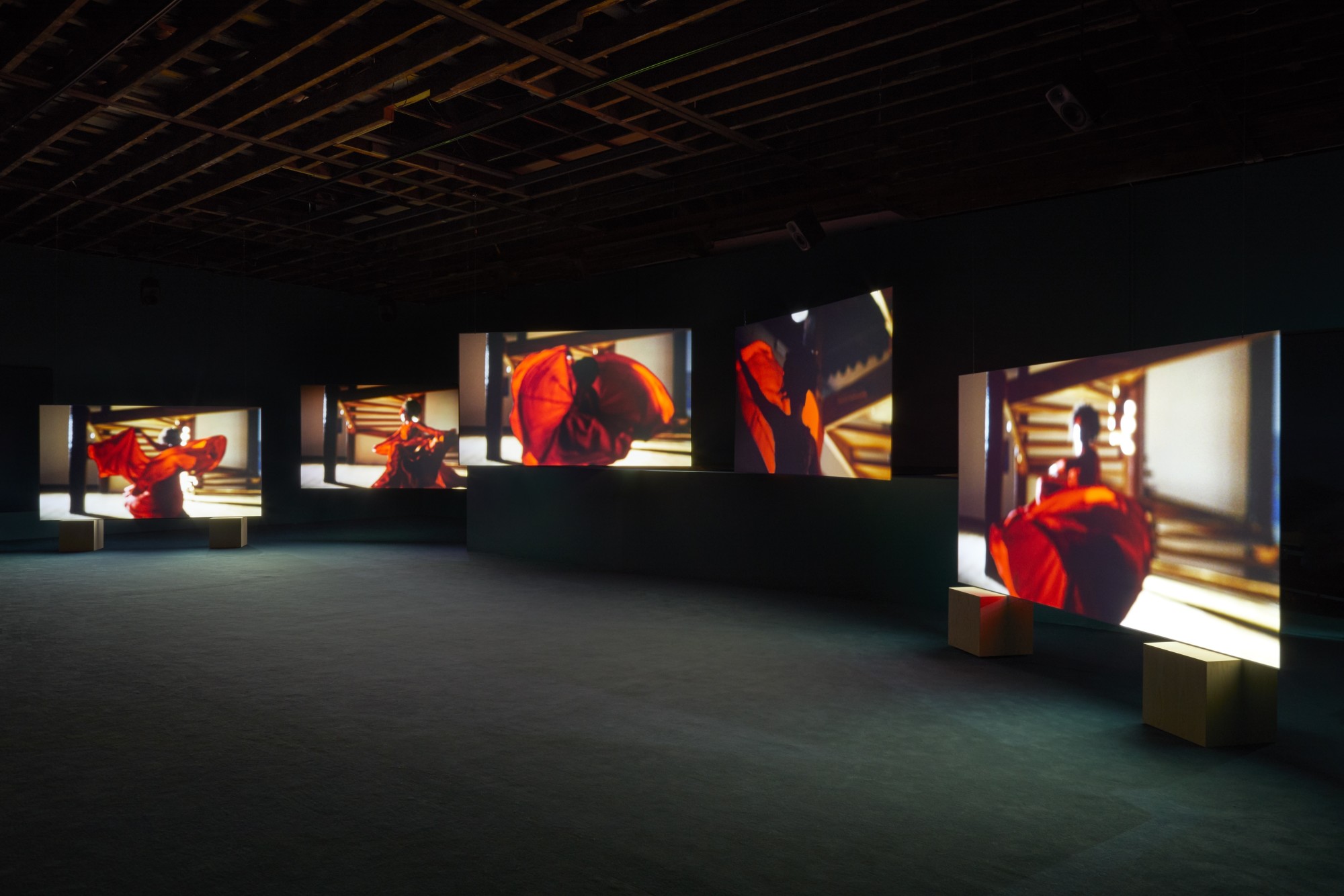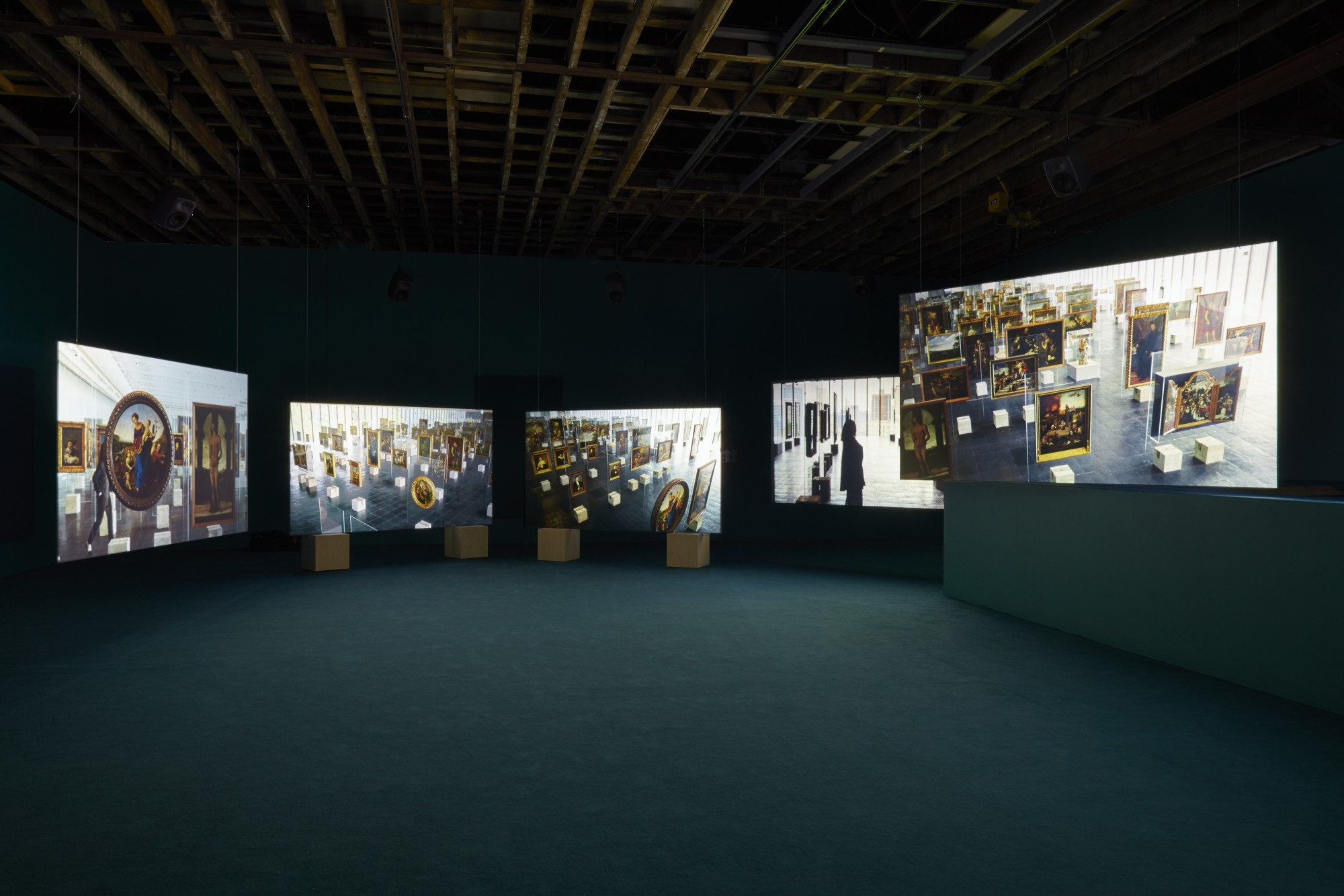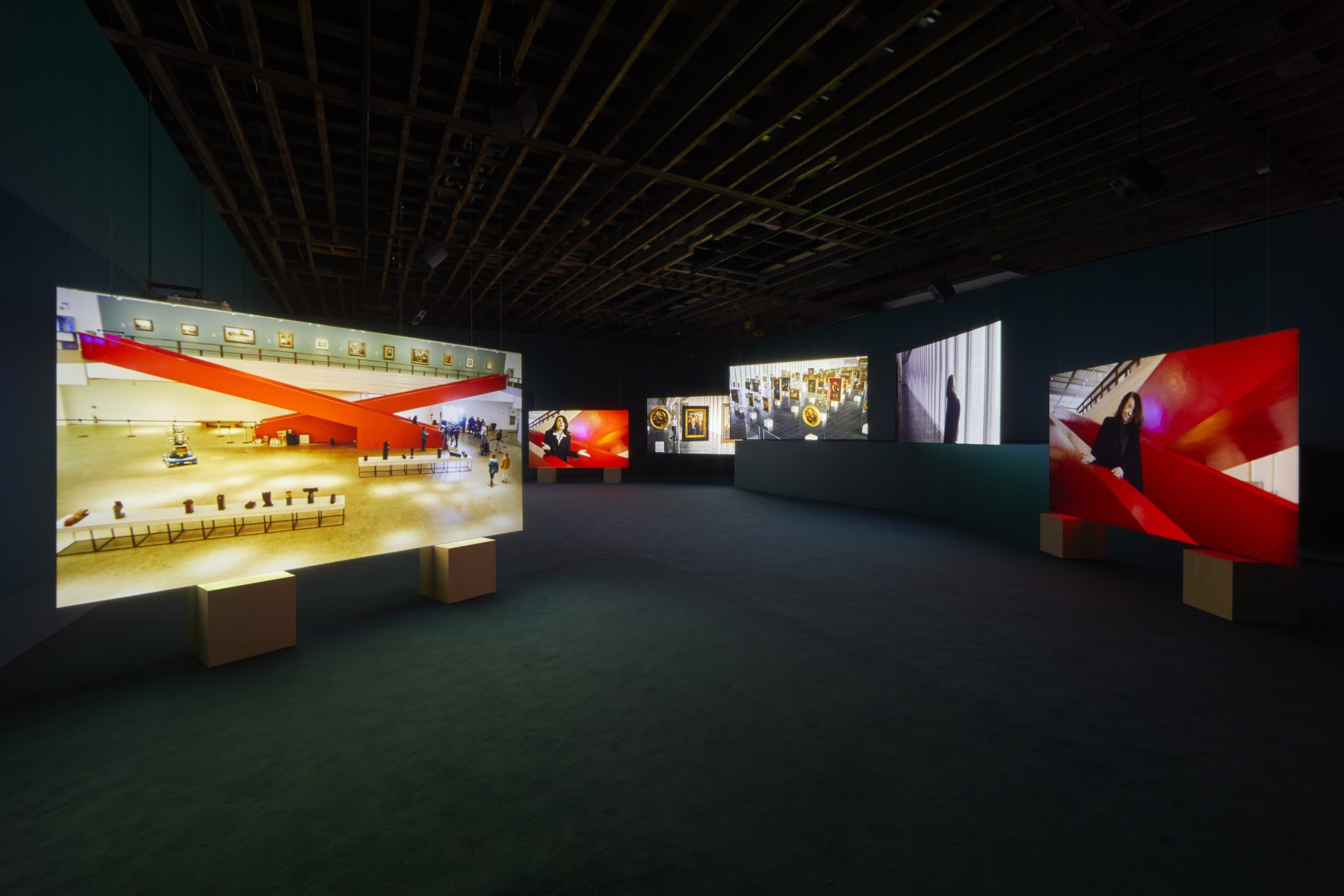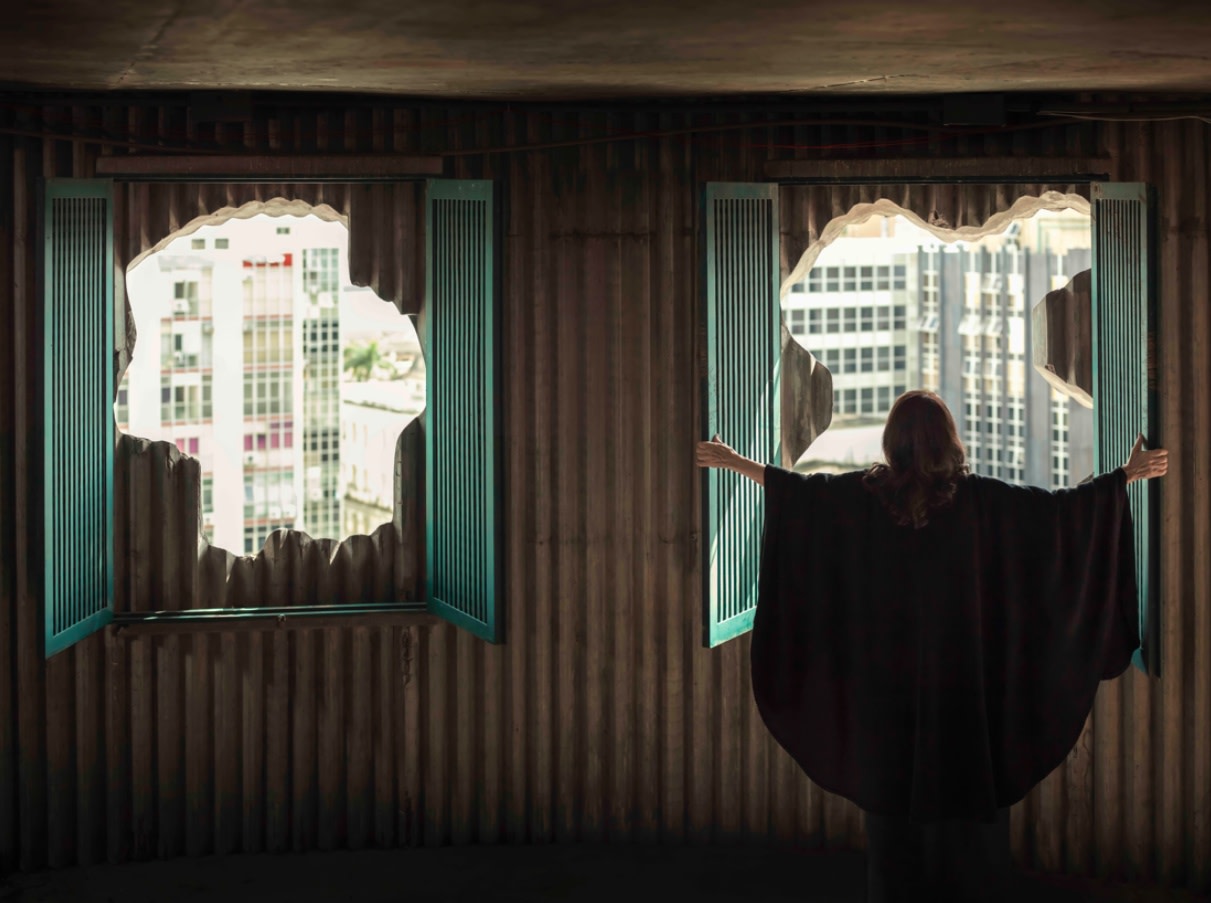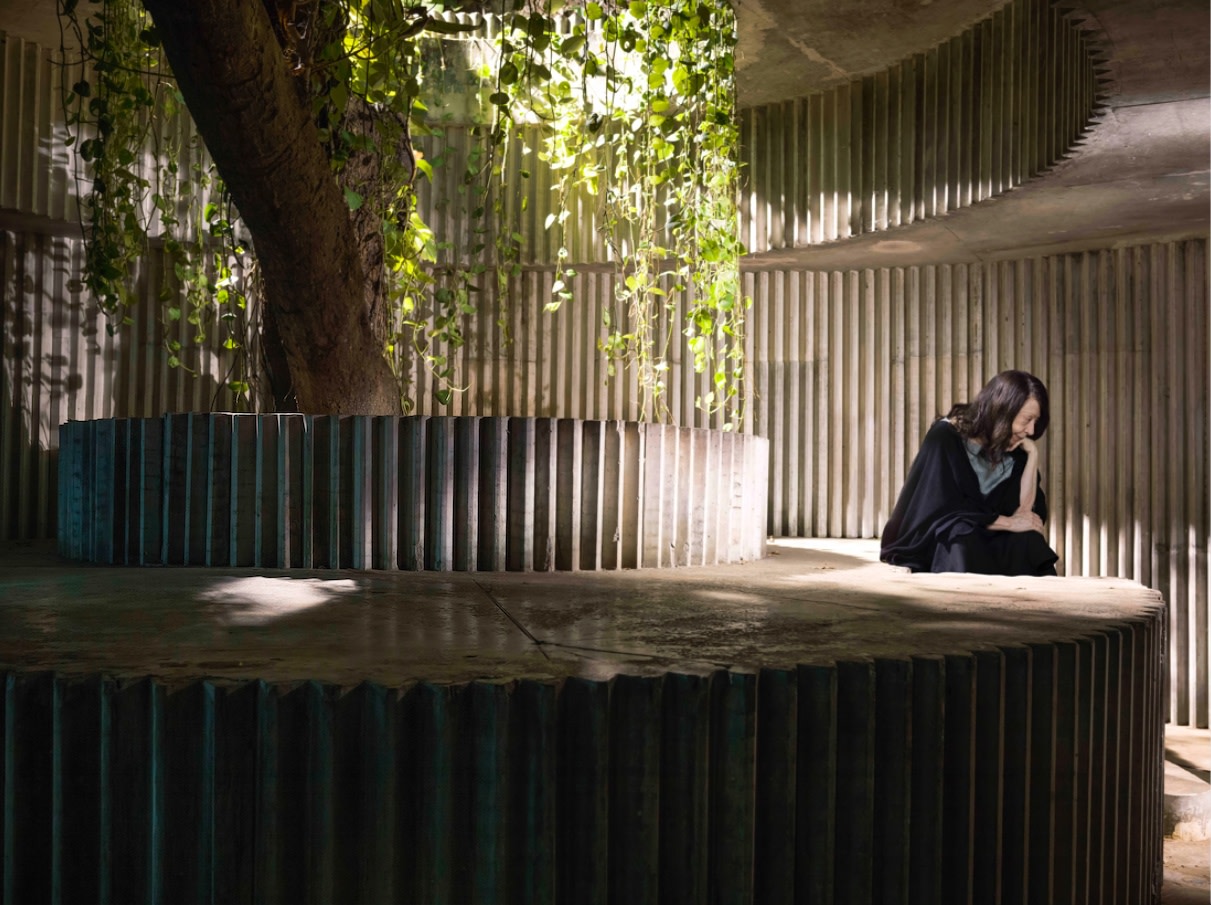The multiple screen installation and photographic series A Marvellous Entanglement (2019) traverses a collection of Lina Bo Bardi’s most iconic buildings, offering a meditation on the work and legacy of the visionary modernist architect and designer (1914–1992).
‘Linear time is a western invention; time is not linear, it is a marvellous entanglement where, at any moment, points can be chosen and solutions invented, without beginning or end.’ – Lina Bo Bardi
Focusing on Bo Bardi’s public projects instead of private edifices, the piece emphasizes her social, political and cultural views, alongside her philosophical reflections formulated in articles and letters, such as the passage above, which is central to the film.
Having filmed on location in São Paulo Museum of Art (MASP), Sesc Pompeia and in the Teatro Oficina, Julien proposes an open-ended reflection on Bo Bardi’s ideas. These three buildings, widely regarded as landmarks of Brazilian modernism, stand as representative of her ground-breaking vision. Travelling further north, the work also encounters Bo Bardi’s buildings in Salvador: the Museum of Modern Art; the Coaty Restaurant and the Gregório de Mattos theatre. Starring Academy Award-nominee Fernanda Montenegro and her daughter, Cannes-laureate actor Fernanda Torres, A Marvellous Entanglement portrays Bo Bardi at different stages of her life, as the actresses interpret excerpts from the architect’s writings.
A central figure of Latin American modernist architecture, Bo Bardi devoted her working life to promoting the social and cultural potential of art, architecture and design. Exploring these themes, A Marvellous Entanglement uses the iconic staircase that she designed for the Museum of Modern Art, Bahia, as the stage upon which Julien orchestrates an original work by choreographer Zebrinha, performed by the Balé Folclórico de Bahia. The Coaty, a modern ruin perched on the Ladeira de Misericórdia in Salvador, accommodates in turn a series of performances by Brazilian art collective Araká. In close collaboration with Julien, the collective performs in situ happenings reflecting upon the significance of Bo Bardi’s seldom-accessed masterpiece for a young contemporary audience. Another leading name of Brazilian arts, the actor, director, playwright and co-founder of São Paulo’s Teatro Oficina, José Celso Martinez Corrêa (AKA Zé Celso) worked in close collaboration with Bo Bardi and is also a key presence in the film, which includes score created by the German-Spanish composer Maria de Alvear.
Following the conceptual thread which Julien established in his earlier artistic investigations around portrait-making such as Ten Thousand Waves (2010), or the more recent Lessons of the Hour: Frederick Douglass (2019), Lina Bo Bardi – A Marvellous Entanglement looks at historical reparation through visual poetry, moved by the breadth and power of Bo Bardi’s work, and a profound belief that her legacy has yet to be fully acknowledged.
Further reading
Screen idol: Artist Isaac Julien bends time and space to celebrate Brazilian architect Lina Bo Bardi on film
by Nick Compton, Wallpaper Magazine*
In a darkened room flashes of looming concrete walls and extruded limbs – serial images of Lina Bo Bardi’s SESC Pompeia art and leisure centre in São Paulo – pulse to a score by the German-Spanish composer Maria de Alvear. The artist and filmmaker Isaac Julien and his editor Adam Finch – the room is part of Julien’s David Adjaye-designed studio overlooking a stretch of Regent’s Canal in north London – are working on the complex choreography of footage that will eventually play across nine carefully placed 6ft-tall screens and make up the seven distinct sections of his new work, Lina Bo Bardi – A Marvellous Entanglement. It’s a kind of dancing-about architecture and a dizzying work.
Five years, on and off, in the making, the piece is Julien’s multi-part tribute to the Rome-born polymath modernist who became Brazil’s most significant architect outside of Niemeyer. Though a long way from a straight-ahead biopic – Bo Bardi would have hated anything so linear and reductive, he says – Julien wanted to make clear Bo Bardi’s creative stretch: her smarts as writer and essayist (she worked with Gio Ponti at Domus in the mid-1940s), furniture designer, exhibition designer, costume designer, theatre designer, jewellery designer, as well as her celebrations of Brazilian pop and folk culture, her role as cultural lightning rod, and her commitment to architecture as activated social space for all. Bo Bardi’s reputational stock may have risen remarkably over the last decade, but Julien insists she is still underappreciated.
His passion for Bo Bardi’s life and work began in 2012 when he was invited to show at SESC Pompeia. Completed in the mid-1980s and designed around the husk of a retired oil drum factory, Julien calls it a tropical version of London’s Hayward Gallery but with more community outreach. ‘They run all kinds of activities – sport, dance, theatre, music, art exhibitions. It’s really utopian and the architecture is amazing.’
Julien worked with the local architect André Vainer on the installation of his SESC show, ‘Geopoetics’. Vainer had worked with Bo Bardi on the design of the building and its creative fixtures and fittings. ‘And it dawned on me that he was using all these techniques that Bo Bardi had developed for the display of the work; from the use of the materials to how the name of the show and other information was presented. That’s when I became really interested in all things Bo Bardi.’ (Julien was so enamoured of Bo Bardi’s art display devices, simple wooden ladder systems and stark concrete plinths with glass easels designed for SESC Pompeia and her Museu de Arte de São Paulo (MASP), that he had his own made. He used them for his recent Lessons of the Hour – Frederick Douglass installation at the Metro Pictures gallery in New York.)
More fundamentally, the show and the installation made him think about the mechanics of his own art. Julien has made his reputation with multi-screen video installations, often shown with related still photography. His work – from 1989’s Looking for Langston, through Vagabondia (nominated for the Turner Prize in 2001), Baltimore, Fantôme Afrique to Ten Thousand Waves and Playtime combines crystalline, lyrical imagery, dance and documentary, looped and fractured narratives and the occasionalappearance of high-wattage stars, including James Franco and Maggie Cheung. Taking in his multiple screens requires fluid, mobile viewing, a constant flutter and flow.
‘That was one of the things I realised at SESC Pompeia; there was a choreographic conversation happening in the way Lina Bo Bardi worked scenographically,’ Julien says. ‘I had a light bulb moment in relation to my thinking about space and architecture and the distribution of images in space.’
In 2013 Julien created the poster for ‘The Ghost of Lina Bo Bardi’, an exhibition curated by Hans Ulrich Obrist at The Glass House, the architect’s former home in São Paulo. And his 2015 piece Stones Against Diamonds was inspired by a Bo Bardi letter to her husband and featured a CGI version of her staircase at the Museu de Arte Moderna de Bahia (MAM Bahia), constructed using techniques usually used in the making of ox carts. Bo Bardi managed to incorporate vernacular techniques and materials into her work more successfully than perhaps any other great modernist, a commitment which makes her work feel utterly contemporary and key to the resurgence of interest. ‘Like many emigrés, she looked at the country from a fresh perspective,’ says Julien. ‘She embraced the craftsmanship of its north east and reflected a more organic Brazilian culture back to itself.’
Over the last couple of years, Julien has shot across seven Bo Bardi-designed locations: SESC Pompeia, MASP and, also in São Paulo, Teatro Oficina, her final project; as well as four buildings in Salvador, the capital of the northeastern state of Bahia, where Bo Bardi lived and taught for five years. Julien has a particular passion for Bo Bardi’s work in the city, where half the population are descendents of men and women forcibly hauled from west Africa to work in Brazil’s plantations and gold and diamond mines. He shot the Casa do Benin, which Bo Bardi designed with the French-born photographer Pierre Verger, and Coaty, a social housing and restaurant project built on the ruins of the area between the port and the historic centre of the city. The project was never opened and it too quickly fell into ruin. The site is now guarded by the military police, a force to be reckoned with in Brazil, and Julien spent two years wrangling before gaining access.
Julien picks up and riffs on Bo Bardi’s own architectural riffs, her staircases and wall openings, her careful engineering of public places and her buildings’ relationship to nature. But the buildings are also sites for intervention, or ritual even. Very much in the spirit of Bo Bardi, and as the name suggests, A Marvellous Entanglement is a mass of creative collaborations. Julien again makes use of the staircase at MAM Bahia, inviting the local choreographer Zebrinha and the Balé Folclórico da Bahia dance company to create a staircase-specific piece. At Casa do Benin, Julien installed fabrics by the artist Goya Lopez, an homage to Marielle Franco, the (black, female) politician and human rights activist shot dead in Rio last year by a local militia with possible links to the current president Jair Bolsonaro. At Coaty there is performance by young Salvadoran actor Diego Pinheiro. Bo Bardi also appears in the piece, played by Fernanda Montenegro, the 89-year-old grande dame of Brazilian film and theatre, and her daughter Fernanda Torres. The two are often on screen at the same time, reading extracts from Bo Bardi’s writing, a smart looping of time which unspools any sense of traditional biopic linear momentum.
For Julien, this is not a history of Bo Bardi in Brazil or any kind of summing up. He is after the ‘sensation’ of her work. ‘We can leave the historic Bo Bardi to the historians. Of course there is a great documentary to be made about her, that’s just not what we are doing. The thing we want to communicate is the architecture, the movement, the dynamism of it. And to use her ideas. And ask what Lina Bo Bardi and Brazil mean today. These are the questions we want to explore.’
*courtesy of Wallpaper, originally published on issue 243/June 2019.


